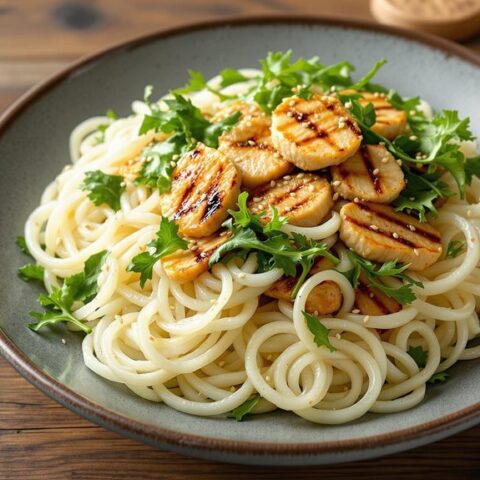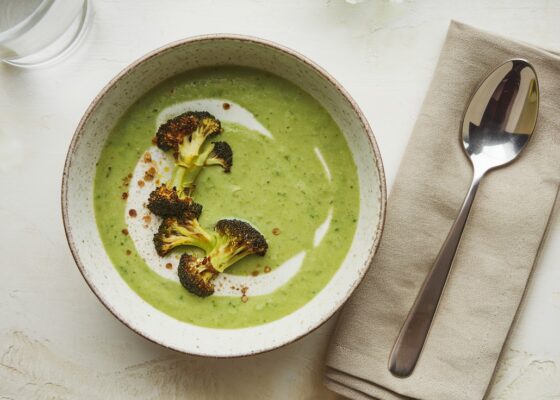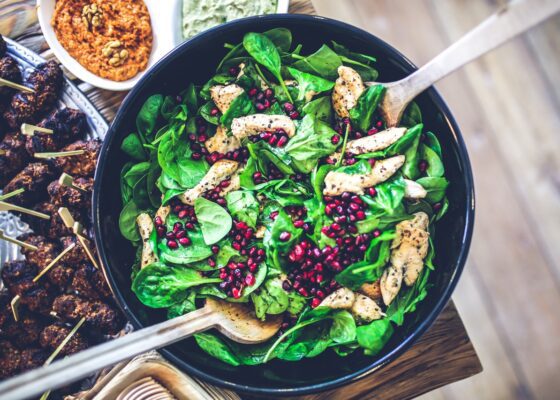
Bananas can be included in a low-carb diet, but require careful consideration due to their high carbohydrate content of approximately 27 grams per medium fruit. The ripeness level affects their glycemic impact, with less ripe bananas containing more resistant starches and fewer sugars. While bananas offer valuable nutrients like potassium and vitamin B6, portion control is essential. Strategies such as choosing smaller fruits, limiting frequency, and proper timing can help incorporate bananas while maintaining low-carb goals. Understanding the complete nutritional profile enables smarter dietary decisions.
Key Takeaways
- Bananas contain 27g of carbs per medium fruit, making them challenging to fit into most low-carb diets' daily allowances.
- Less ripe bananas have fewer net carbs (21g) and lower glycemic impact due to higher resistant starch content.
- Portion control strategies include choosing smaller bananas, eating half portions, or using thin slices as recipe ingredients.
- Bananas can work in low-carb diets when eaten post-workout or paired with protein and fats to balance blood sugar.
- Consider alternatives like berries, which offer similar nutrients with significantly fewer carbohydrates per serving.
Understanding Banana's Nutritional Profile
Bananas, a beloved tropical fruit, present a complex nutritional profile that requires careful consideration for those following a low-carb diet. With approximately 27 grams of carbohydrates in a medium banana, this fruit falls firmly into the high-carb fruit category, potentially challenging those monitoring their carb intake.
While bananas offer significant health benefits through their potassium, vitamin C, and vitamin B6 content, their net carbs remain substantial even after accounting for fiber content.
The carb content becomes particularly relevant when considering that most low-carb diets restrict daily carbohydrate intake to 20-50 grams. Although the 3 grams of fiber help moderate sugar absorption, the overall carbohydrate load makes bananas a fruit that requires careful portion control or limited consumption for those strictly adhering to a low-carb eating plan.
The Carbohydrate Content of Bananas
A banana's carbohydrate content varies considerably based on its ripeness, with unripe bananas containing more resistant starch and fewer simple sugars compared to their ripe counterparts.
The net carbohydrate calculation reveals that a medium banana typically contains about 24 grams of net carbs after accounting for fiber content, making it a considerable investment for those following low-carb eating plans.
Understanding these variations in carbohydrate content allows individuals to make informed decisions about portion sizes and timing of banana consumption within their dietary framework.
Ripe Vs Unripe Carbs
The carbohydrate content in bananas varies markedly based on their ripeness level, making it vital for low-carb dieters to understand these differences.
A medium banana's carbohydrate profile changes considerably as it ripens, with unripe bananas containing fewer carbs than their riper counterparts.
Key differences in banana carbohydrate content include:
- Ripe bananas contain approximately 27 grams of carbs, primarily from natural sugars.
- Unripe bananas have about 21 grams of carbs, with more complex starches.
- As bananas ripen, starches convert to sugars, increasing their overall carbohydrate content.
For those following a low-carb diet, portion size remains vital regardless of ripeness level.
While unripe bananas offer a lower carb option, both varieties still contribute considerably to daily carbohydrate limits and should be consumed mindfully.
Net Carb Breakdown Analysis
Understanding net carbohydrates proves essential for anyone following a low-carb diet, particularly when incorporating bananas into their meal plans.
A medium banana contains approximately 27 grams of total carbohydrates, with fiber accounting for about 3 grams, resulting in 24 grams of net carbs. For those adhering to a low-carb diet with a daily carb intake ranging from 20 to 100 grams, a single banana could represent a significant portion of their allowance.
The fruit's high carb content, combined with its natural sugars, can lead to spikes in blood sugar levels that may interfere with dietary goals. While choosing smaller or less ripe bananas might slightly reduce the carbohydrate impact, bananas remain relatively high in carbs regardless of size or ripeness.
Net Carbs vs. Total Carbs in Bananas
When looking at bananas on a low-carb diet, understanding the difference between net and total carbs becomes essential, as a medium banana contains 27 grams of total carbs but only 24 grams of net carbs after subtracting fiber.
The carbohydrate content in bananas can vary greatly based on ripeness, with riper bananas containing more readily available sugars than their greener counterparts.
For those closely monitoring their carbohydrate intake, these calculations become particularly important, as even a single banana can constitute a substantial portion of their daily carb allowance.
Calculating Banana's Hidden Sugars
Maneuvering banana consumption on a low-carb diet requires careful consideration of both total and net carbohydrates.
When examining a medium banana, understanding its sugar composition reveals important insights for those monitoring their carbohydrate intake:
- Total carbohydrates amount to 27 grams, with 14 grams being natural sugars.
- Fiber content of 3 grams reduces the net carb count to 24 grams.
- Blood sugar impact remains significant despite the fiber content.
For individuals following a ketogenic diet or low-carb eating plan, these numbers emphasize the importance of portion size management.
While the fiber content slightly mitigates the carbohydrate load, the substantial amount of natural sugars means bananas should be consumed strategically, potentially balanced with other lower-carb foods to maintain daily carbohydrate limits effectively.
Ripeness Affects Carb Content
The ripeness level of a banana directly influences its carbohydrate composition, making it an important factor for low-carb dieters to take into account.
When monitoring carb intake, understanding the relationship between ripeness and sugar content becomes vital for making informed dietary choices.
A less ripe banana contains approximately 23 grams of net carbs, while total carbohydrates typically measure around 27 grams per medium fruit.
As bananas ripen, their starches naturally convert to sugars, increasing the net carbs by roughly 5 grams.
This transformation results in ripe bananas having a higher sugar content, which can markedly impact a low-carb diet.
For those maintaining strict carb count low requirements, choosing slightly underripe bananas offers a practical way to reduce overall carbohydrate consumption while still enjoying this nutritious fruit.
Glycemic Impact of Bananas
Understanding bananas' glycemic impact proves essential for individuals following a low-carb diet, as these fruits can greatly influence blood sugar levels and daily carbohydrate limits.
While bananas are sweet and juicy, their glycemic impact varies depending on ripeness, with values ranging from 42 to 62 on the glycemic index.
Key considerations for blood sugar control when consuming bananas include:
- Riper bananas contain more sugar and have a higher glycemic impact
- The 27 grams of carbs per medium banana can quickly consume daily carb limits
- Being high in fiber helps moderate the increase in blood sugar levels
To minimize glycemic impact while enjoying these low-carb fruits, consider pairing them with protein or healthy fats, which can help slow down sugar absorption and maintain better blood sugar control.
Benefits and Drawbacks for Low-Carb Dieters
When considering bananas on a low-carb diet, individuals must weigh both significant advantages and notable limitations. While bananas offer essential nutrients, their high carbohydrate content presents challenges for those focused on weight management and blood sugar control. A medium banana contains roughly 27 grams of carbs, which can quickly consume a substantial portion of daily carb allowances on restricted eating plans. For those committed to a low-carb diet, careful portion control becomes vital when incorporating bananas. Some may opt to eat smaller portions of less ripe bananas, though even these remain relatively high in carbs. Many dieters find success by choosing alternatives like berries, which provide similar nutritional benefits while maintaining lower carbohydrate levels, making them more suitable for strict low-carb eating plans. The ketogenic diet greatly reduces blood glucose levels and stabilizes HbA1c, which is beneficial for managing type 2 diabetes.
Smart Ways to Include Bananas While Low-Carb
Despite their high carbohydrate content, bananas can still be incorporated strategically into a low-carb eating plan through careful portion control and thoughtful food pairings.
For those committed to maintaining their low-carb diet while enjoying this versatile fruit, consider these practical approaches:
- Practice portion control by selecting smaller, less ripe bananas and cutting them into thin slices.
- Combine banana portions with healthy fat foods, such as nut butter or yogurt, to help regulate blood sugar levels.
- Use minimal amounts of mashing banana as a natural sweetener in low-carb recipes.
Some people opt for keto-friendly sweeteners like stevia or erythritol to balance sweetness without increasing carbs.
Successful integration of bananas requires moderation, perhaps limiting consumption to once weekly while primarily choosing lower-carb fruits like berries for regular snacking.
This approach helps maintain carb limits while still enjoying the nutritional benefits bananas offer.
Alternative Fruits for Low-Carb Eating
While bananas may present challenges for low-carb dieters, numerous alternative fruits offer similar nutritional benefits with considerably fewer carbohydrates per serving.
For those seeking healthy low-carb options, berries emerge as excellent choices, with raspberries containing just 1.7 grams of carbs per quarter cup and strawberries offering moderate carb content that fits well within daily limits.
Avocados stand out among alternative fruits, providing healthy fats and fiber while keeping carb intake minimal.
For variety, peaches can be enjoyed in moderation, offering a sweet taste with manageable carb levels when properly portioned.
Those prioritizing hydration can turn to watermelon and cantaloupe, which deliver invigorating satisfaction while maintaining reasonable carb counts, making them suitable choices for low-carb lifestyle adherents.
Spinach is a keto-friendly vegetable that can also be enjoyed in moderation, with just 1 gram of carbs per cup, and is high in iron, magnesium, and antioxidants.
Portion Control Strategies for Banana Consumption
Effective portion control begins with selecting smaller bananas, ideally those measuring 6-7 inches in length, which naturally contain fewer carbohydrates than their larger counterparts.
Strategic timing of banana consumption, particularly before or after physical activity when the body can better utilize the natural sugars, helps optimize carbohydrate allocation within a low-carb eating plan.
Small Banana Size Guide
Since bananas can be challenging to incorporate into a low-carb diet, understanding proper portion sizes becomes vital for successful carbohydrate management. A typical small banana contains 20-23 grams of carbohydrates, which can greatly impact daily carb limits.
To effectively include bananas while maintaining a low-carb lifestyle, consider these key guidelines:
- Select smaller bananas, which naturally contain less sugar and fewer carbohydrates.
- Cut portions in half, reducing carb intake to approximately 10-12 grams per serving.
- Pair banana servings with protein or healthy fats, such as nut butter, to help regulate blood sugar levels.
Careful tracking of carb intake remains important when incorporating bananas into a low-carb diet, ensuring daily targets are maintained while enjoying this nutritious fruit in moderation.
Timing Your Banana Intake
Beyond selecting appropriately sized bananas, the timing and manner of consumption play essential roles in successfully incorporating this fruit into a low-carb eating plan.
Strategic timing of carb intake around physical activity enables the body to utilize banana sugars more efficiently for energy during workouts. To mitigate blood sugar spikes, consume half banana portions paired with protein or healthy fats, such as nut butter.
The key to maintaining lower sugar content impact lies in treating bananas as occasional snacks rather than daily staples. By consuming small amounts in moderation and choosing less ripe specimens, individuals can better manage their carbohydrate intake while still enjoying this nutritious fruit's benefits.
This measured approach allows for dietary flexibility while maintaining carb-conscious goals.
Balancing Daily Carb Budget
Managing banana consumption within a low-carb diet requires careful attention to portion control and daily carbohydrate allocation. When incorporating bananas into a low-carb diet, individuals must carefully track their carb intake to maintain their daily carb budget while still enjoying this nutrient-rich fruit.
To effectively balance banana consumption within a low-carb diet:
- Monitor serving sizes by limiting portions to half or quarter of a medium banana.
- Track daily carb intake using food tracking apps or journals to guarantee adherence to carb limits.
- Pair banana servings with healthy fats or protein sources to minimize blood sugar impact.
This strategic approach to portion control allows individuals to enjoy bananas while maintaining their low-carb lifestyle, provided they account for the 27 grams of carbohydrates in a medium banana within their daily allowance.
Timing Your Banana Intake on Low-Carb
When incorporating bananas into a low-carb diet, strategic timing can make a considerable difference in maintaining ketosis and achieving dietary goals. The ideal time for banana intake is immediately following a workout, when the body efficiently utilizes carbs for muscle recovery without greatly disrupting daily carb limits. To maximize benefits while minimizing blood sugar impact, pairing banana consumption with protein or healthy fat sources, such as nut butter, creates a more balanced nutritional profile. Those following strict low-carb protocols should consider portion control by selecting smaller, less ripe bananas and treating them as occasional additions rather than daily staples. This measured approach to timing and moderation allows individuals to enjoy bananas while staying within their carbohydrate restrictions. For athletes, ketosis enhances fat oxidation, making it beneficial to align carbohydrate intake with periods of increased energy demands.
Recipe Modifications Using Bananas
Low-carb recipe adaptations offer numerous ways to incorporate bananas thoughtfully while maintaining dietary goals. Smart modifications can help control carbohydrate intake while preserving the beloved banana flavor in various dishes.
Consider these effective recipe modifications:
- Replace sugar with mashed bananas in baking recipes, using smaller, less ripe fruits to minimize natural sugars.
- Combine half a banana with low-carb ingredients like spinach or avocado in smoothies for creamy texture.
- Top low-carb yogurt with minimal banana slices for flavor without excessive carbs.
For those seeking even lower carb alternatives, banana flavor extracts provide the desired taste without impacting the carb count.
These adaptations allow for creative cooking while adhering to dietary restrictions, making it possible to enjoy banana-flavored treats on a low-carb regimen.
Frequently Asked Questions
Can I Still Eat Bananas on a Low-Carb Diet?
While bananas offer nutritional benefits, their high glycemic index makes them challenging on low-carb diets. Strict portion control or choosing low-carb fruit alternatives like berries better supports ketosis and healthy snacking goals.
Can I Eat Anything Sweet on a Low-Carb Diet?
Sweet snacks are possible on low-carb diets through careful portion control and smart choices. Sugar substitutes, select fruit choices, and healthy desserts can satisfy cravings while adhering to dietary guidelines.
Can I Eat Bananas on a Low Sugar Diet?
While bananas' high sugar content and glycemic index make them challenging for low-sugar diets, consuming smaller portions or choosing fruit alternatives like berries offers better nutrition benefits while maintaining healthy snack options.
Are Carbs From Fruit the Same as Carbs From Bread?
Carbohydrates from fruit differ markedly from bread carbs, offering natural sugars, higher fiber content, and superior nutrient density. Fruit's lower glycemic index and beneficial compounds create healthier metabolic responses than bread's refined carbohydrates.
Conclusion
While bananas can be incorporated into a low-carb diet, careful portion control and timing are essential. Though higher in carbohydrates than many fruits, their nutritional benefits can still be enjoyed by limiting serving sizes and considering ripeness levels. For those following strict low-carb regimens, alternative fruits may be more suitable, but moderate banana consumption remains possible through mindful planning and strategic meal timing within daily carbohydrate allowances.










No Comments